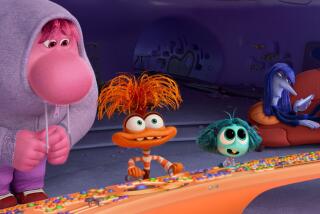Book Review : The Brain Busily Thinking About Itself
- Share via
Memories of Amnesia by Lawrence Shainberg (Paris Review Editions/British American Publishing: $16.95; 219 pages)
If the moon and stars should doubt, William Blake remarked, they’d immediately go out. And if the human brain should think too inquisitively about itself, Lawrence Shainberg tells us, it would burn out.
This is the plot, though not quite the theme, of Shainberg’s speculative novel, “Memories of Amnesia.”
Its protagonist is a neurosurgeon who incurs brain damage by staring steadily at that old philosophical sprite, the ghost in the machine. Precisely where does the soul reside?, the 17th Century asked, and how is it connected to the body? For Shainberg, it is not the soul but the self--the “eye”--but it comes to the same thing.
Only last week, a window screen blew off and its metal edge banged me on the head, hard. It hurt; but what gave me headache and dizziness afterward was thinking about my brain and wondering if it was bruised. That is, my brain thought about my brain. Or was it my brain thinking about me? Who or what was thinking about whom or what?
A Provocative Risk
So, it was a chancy week to read “Memories,” but even book reviewers must face the risks of their profession. “Memories” made a diverting and provocative risk; though now and again, it inflicted a queasy screen-memory.
Dr. Isaac Drogin began to think and behave oddly one day while operating on an epileptic patient under local anesthesia. He was focusing on her brain, of course; laid open for his instruments. But he caught sight of her eye, as well, staring at him. What was staring?: the person whose eye he glimpsed, or the wrinkled gray mass of flesh he was working on?
“Circularity, we call it,” Drogin tells us. “Excessive reflection within the brain about the brain itself. You find yourself thinking that the tissue you’re looking at is looking back at you. Nothing is more dangerous in a neurosurgeon, and as I see it, something in my brain found it, circularity, I mean, irresistible.”
And something in Drogin begins to slip. He is convinced that he has never seen a brain before. He calls the patient by a wrong name, knowing quite well what her real name is. He sings “Oh Susanna” in a raucous voice. He feels exhilarated. And here, his story bifurcates.
As a man of science, Drogin immediately suspects a beginnings of brain damage in himself. Perhaps it is in the cells that control memory; perhaps it is in the motor cells; perhaps it is in those that control volition.
This kind of observation and logging continues when he finds himself behaving erratically with another brain patient, when he goes home and finds that he is temporarily unable to move (or does not choose to--is it lower or higher brain centers?), that he is unsure of his wife’s name, that his feelings oscillate wildly between fury and tenderness.
Shainberg, who has written a nonfiction book about neurosurgery, describes exquisitely the incipient signs of brain illness:
“It’s true that it can strike like a hurricane, but sometimes it’s more like a gentle breeze, a subtle change of vectors that leaves you headed not in the opposite direction, but almost exactly where you were headed before. A charming eccentricity becomes obnoxious, private habits go public,” he writes.
“Why should we be surprised that when it goes askew it proceeds at first along familiar routes, taking the line of least resistance, like water flowing down a mountain or an artist painting portraits of his friends?”
One Track of the Story
But this is only one track of the story. Drogin’s observations are the work of his brain; they tell him he is ill, irrational. But why should he believe an ill brain?
Is brain damage simply a concept “which, all our lives, our brain has used to frighten us into submission?” he demands. Does the brain arbitrarily define health as submission to its authority? Could the brain-damaged patients in his ward really be revolutionaries, in fact, against the brain’s tyranny?
And, finally, is his own odd sense of exhilaration at charting his symptoms a glimpse of freedom?
The questions, of course, could themselves be a product of brain disease. But once you have broken down the distinction between the brain as a physical organ, and the brain as yourself, how are you to know?
“Memories” will eventually have Drogin going to the hospital for a brain probe. Locally anesthetized, he will monitor and report on it. It is to be a grand experiment; he will be on both sides of the question. He will simultaneously observe the workings of his brain from the outside, and register its workings as part of his Self.
It is a fascinating confrontation; though intrinsically unworkable. The climax is a swirl of words and sensations. Drogin reaches up with a hand and seems to crush his brain, destroying it. It must be a hallucination, the reader supposes; otherwise the narrator would not be telling us about it.
Philosophically, it resolves nothing. Is Drogin symbolically punishing his brain? Is his brain punishing Drogin? The old mind-body question remains where it was.
Except, that we have had an exhilarating roller-coaster trip around it, even if the roller coaster gets stuck for a while at some especially precipitous points. Shainberg’s book, in the tradition of such didactic works as “Flatland” and “Erewhon,” is not really a novel, any more than Plato’s Symposium is real dinner talk. But it is audacious, fertile and fun.
More to Read
Sign up for our Book Club newsletter
Get the latest news, events and more from the Los Angeles Times Book Club, and help us get L.A. reading and talking.
You may occasionally receive promotional content from the Los Angeles Times.










